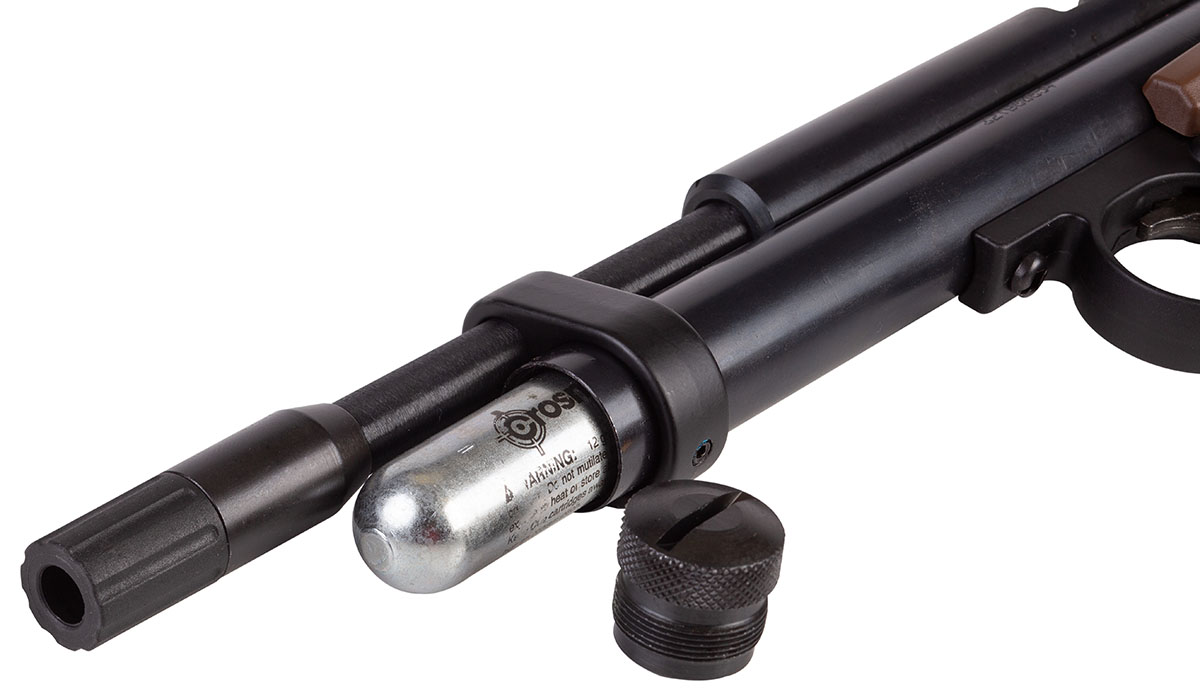As we dive deeper into the world of modern airguns, let’s unravel the mysteries of CO2 power plants. CO2, a distinctive airgun propellant, presents a host of advantages and a few drawbacks. Its unique properties enable manufacturers to craft airguns that function in semi-automatic and full-automatic modes. The compact size of the 12-gram CO2 cartridges facilitates their seamless integration into grips and magazines, lending an incredibly authentic look and feel to the airgun.
How CO2 Works
CO2 is not shipped as a compressed gas but as a liquid. At room temperature, compressed CO2 liquid maintains a relatively stable 900 PSI. This is why many entry-level 10-meter precision airguns are powered by CO2. You don’t need a complex and costly PCP filling system or regulator to achieve excellent results. Because CO2 operates at 900 PSI, it’s inherently self-regulated. As long as there’s enough volume, CO2 will consistently deliver 900 PSI shot after shot. However, there is a minor drawback.
As CO2 is released from the storage vessel, it cools down rapidly. When CO2 cools, the pressure drops. The more CO2 that’s released, the faster the container cools and the lower the pressure goes. So, while dumping a full mag running full auto is a lot of fun, it also degrades the CO2’s performance very quickly. It may take several minutes for the CO2 cartridge to warm back up and shoot at its full potential. This also means that CO2 will not operate at the full 900 PSI in cold weather. Ideally, you want your ambient temps between 75 and 95 degrees.
The Mechanics
Mechanically, CO2 airguns work the same as most PCP airguns. There’s a reservoir of pressurized gas, in this case CO2 vs. air, that’s held back by a valve. When the valve is opened, usually by a hammer or some sort of striker, a portion of the CO2 is instantly converted from liquid to gas, and the expansion sends the BB or pellet down the barrel.
What About Blowback CO2 Airguns?
While the general operation of firing a projectile may be the same, there are other unique aspects of CO2 airguns. You’ll commonly hear the term “blowback.” Since CO2 is often used with replica airguns, creating the most realistic experiences is key. Let’s take the iconic Colt 1911. A “real” 1911 has a heavy metal slide that cycles with each round, loading the next bullet into the breech. A CO2 1911 “blowback” pistol will channel some of that CO2 to actuate a top slide, simulating the same blowback that you’d have with the firearm. Some CO2 guns use this blowback action to cock the hammer, just as you’d find in the actual firearm.
Overcoming the Drawbacks
Let’s get back to the main drawback to CO2 as an airgun propellent. It’s not great in cold weather, and it can freeze up when shot too rapidly. So, how have manufacturers sought to work around this problem? Well, when it comes to cold weather, there’s really not much you can do. But you can help address poor performance from rapid firing.
One way to overcome the problem is to just have more volume. The introduction of the larger 88-gram CO2 cartridges not only provides a higher shot count but also doesn’t tend to freeze as quickly. Many airguns have adopted these new cartridges with great success, such as the SIG line of AR airguns.
Another option has been to isolate the smaller CO2 cartridge and the valve into unique devices. Often called “drop-free” magazines, the CO2 and valve are self-contained parts. Shooters can have several on hand and simply rotate them as needed, allowing a “just shot” magazine to warm up while shooting from another spare.
These are not perfect “fixes” to the inherent problem, but they do offer shooters the option to get more trigger time with optimal performance.
That’s a Wrap
That’s our look at CO2 and how it’s used in modern airguns. If you have more questions, please be sure to reach out, and we’ll do our best to ensure you get the right answer.
